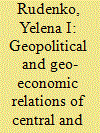|
|
|
Sort Order |
|
|
|
Items / Page
|
|
|
|
|
|
|
| Srl | Item |
| 1 |
ID:
128114


|
|
|
|
|
| Publication |
2013.
|
| Summary/Abstract |
According to many experts on ancient and Medieval history of contacts between Central and South Asian regions in previous centuries, including Janet Rizvi, "the trade from Mysore to Central Asia presented no difficulties". Obviously, not all trades who come to India from Central Asia alongwith their caravans reached coastal part of subcontinent, but rather chose as their final destination, the major cities of North India.
|
|
|
|
|
|
|
|
|
|
|
|
|
|
|
|
| 2 |
ID:
129420


|
|
|
|
|
| Publication |
2014.
|
| Summary/Abstract |
For nearly two decades, the representatives of the official authorities as well as public and private business entities from both Kazakhstani and Indian sides used to talk about the possibility and even the necessity of trade in strategically important types of raw products, including uranium. However, despite throughout the whole of this period, basic goods constitute the lion's share of Kazakhstan's exports to India, but bilateral trade in uranium still remains open to question. An old saying goes: 'The more you know your counterpart, the easier it is for you to deal with him', which is crucially applied to India and Kazakhstan suffering from the lack of mutual awareness. In this regard, it seems quite important to outline main economic, legislative and other aspects related to the uranium industry in Kazakhstan.
|
|
|
|
|
|
|
|
|
|
|
|
|
|
|
|
| 3 |
ID:
086389


|
|
|
|
|
| Publication |
2008.
|
| Summary/Abstract |
While speaking about the theory and practice of international relations, one usually pays attention to their political and economic constituents. Consequently, one evaluates, analyzes, and predicts andy state's success or failure on the blobal arena mainly on the basis of delepments of its political and economic relations with other states.
|
|
|
|
|
|
|
|
|
|
|
|
|
|
|
|
| 4 |
ID:
156971


|
|
|
|
|
| Summary/Abstract |
Cultural and civilisational stratum of existence of South and Central Asian regions and separate states associated with the numerous manifestations of identity (ethnic, confessional, linguistic, etc.) appears an important component of their political, social and economic being at the internal and external levels. At the same time, in the countries of these two regions, there are elements of both similarities and differences in the identity-related sphere that allows performing a look-through comparative-contrasting analysis of their complexes of identities on the basis of correspondence/incongruity to various theories, as well as of actual practice of their materialisation. In this regard, it is viable to discuss issues such as the identity theories in applications to the realities of South and Central Asia, the exposure on and specifics of implementation/non-implementation of the conflict potential of identities in both regions and the transfiguration of identities under the influence of mutual migrations. Immediate positive experience and best practises of implementing the identity policy in the two regions with particular emphasis upon India and Kazakhstan also deserve special attention.
|
|
|
|
|
|
|
|
|
|
|
|
|
|
|
|
|
|
|
|
|